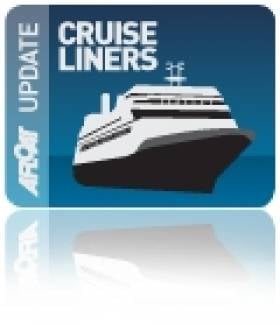Displaying items by tag: Quark Expeditions
Historic First Cruiseship Caller to Drogheda Port to Undergo Major Works to Extend Career
#MajorUpgrade - Polar small cruiseship operator, Quark Expeditions’ whose Sea Adventurer under another guise made a historic first but only cruise call visit to Drogheda Port is to undergo a major renovation, writes Jehan Ashmore.
The former Clipper Adventurer then on charter to Noble Caledonia made the historic occasion by berthing on the Boyne as Afloat reported in 2012 (scroll down for photo) is to undergo a major $8.5 million investment. The project involves renovation and upgrade work beginning in April 2017 at the Ulstein Verft in Norway.
The extensive works to the 4,367 gross tonnage Sea Adventurer will not just be focused on passenger facilities of the 132 traveller /83 crew run ship but significant technical enhancements – including two new engines – to improve fuel efficiency and minimize carbon footprint.
Passenger areas are to recieve a new look and feel throughout with a forward lounge and observation deck to enjoy mesmerizing polar views be it the Arctic or Antartica. As for accommodation, alterations are to include some new cabins and every cabin will get a new bathroom.
On completion of the dry-docking works, she is to emerge as the renamed Ocean Adventurer with a renaming ceremony to take place on 17 June next year for Quark, part of the TUI Adventure Division.
The works are more the remarkable given the veteran vessel has been in service for four decades having been built in 1976 at a Yugoslavian shipyard as the Alla Tarasova. Originally the Russian ship served as a coastal passenger ship for the Murmansk Shipping Company.
To embark on such an investment is down to Sea Adventurer’s structural integrity given a robust ice-strengthened hull. She is one of an octet of similar ships. It was Clipper Cruise Line that had the ship rebuilt almost a decade ago in 2007 for expedition cruising as Clipper Adventurer.
Shine Bright Like A 'Diamond' On Strangford Lough
#DiamondOnStrangford - 'Diamonds' the title to a track that would be familiar to worldwide fans of singer Rihanna, though less known was yesterday's visit of Ocean Diamond to Strangford Lough,Co. Down, writes Jehan Ashmore.
This was understood to be Ocean Diamond's maiden visit to the north under the operation of Quark Expeditions, whose fleet of small ships specialise in Arctic and Antarctic adventure style cruising.
She made a transit through the scenic 'Narrows' as the name suggest is located between the stretch of water between the open sea and lough. Also along these shores is where the villages of Strangford and Portaferry face each other and are connected by car-ferry.
The expedition-polar cruiseship equipped with Zodiacs stowed at the stern then proceeded into Strangford Lough to anchor off the southern side of the scenic shoreline. The lough represents the largest inlet of either these Atlantic Isles, covering 150 km².
The blue hulled livery of Ocean Diamond had previously been an all-white affair commonplace with cruiseships when she was the La Diamant. Arguably she was better known in Irish waters when she held the name Song of Flower.
On Tuesday the 8,482 tonnes Ocean Diamond also made her maiden call to Waterford City where she berthed at the crystal city albeit on the north quays of the Suir. It is understood this was the second out of 18 callers due this season.
The Irish connection with the ship continues in the form of Quark Expeditions new loyalty program marketed as The Shackleton Club. The choice of the club's name is in honour of one of Antarctica's greatest explorers, and created to inspire guests to keep on cruising.
Ocean Diamond in exterior design terms is more that of robust looking super-yacht, and one of the largest of Quark's small expedition ships. She has a maximum of 189 passengers, and with two stabilizers and an ice-strengthened hull, the 1974 built vessel is suited for polar expeditions.
According to Quark, she is one of the newest, fastest, and most eco-friendly ships in Antarctica. There are 101 designed cabins and suites, all with exterior views, and expansive common spaces, a club lounge, and a spacious restaurant.
The ship offers numerous adventure options, plus on-board features such as interactions with photography instructors. After a full day of exploration, passengers can relax, browse books or DVDs in the polar library, or enjoy stunning polar scenery from the sun-lit, panoramic observation lounge.
The marketing publicity for the Ocean Diamond says her passengers travel to one of the world's most remote destinations will also do so in a "greener" fashion. That is to say that Ocean Diamond is the first ship in Antarctica, and in polar travel history, to offer certified CarbonNeutral® voyages.






























































